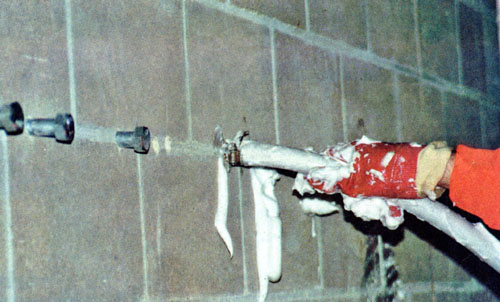Energy Efficiency is MJW Drywall's Main Concern
By Laura Roach
Hampton Union, Tuesday, November 14, 2009
[The following article is courtesy of the Hampton Union and Seacoast Online.]

[Courtesy photo]
HAMPTON — Mike Wilson is receiving a lot of phone calls this time of year.
He is the president and owner of MJW Drywall and Spray Foam Insulation based in Hampton, and he is in the business of energy audits, insulation and drywall. Since the weather has chilled Wilson has seen a lot of customers.
"After the first frost I handle about ten to 20 clients a week," said Wilson.
Most buildings could use about 30 percent less energy if retrofitted with better insulation. Wilson's method of insulation can reduce energy consumption in a household by 65 to 85 percent.
Fiberglass and cellulose are often the insulations used in older homes and they are not always properly installed. When assessing the ability of materials to resist the flow of heat, the term R-value is used.
Fiberglass has an R-value of about three per inch. In contrast, closed cell spray foam has an R-value of about seven per inch. Though high performance spray foam is more expensive than other materials, Mike Wilson swears by it.
"I insulated a ranch (house) that expects to see a savings of about $1,600 a year," he said.
Spray foam insulation by completely sealing a space against air infiltration. It fills in all the spaces from stud to stud, allowing no vapor or air penetration.
Normally air flows from the basement to the roof of a house in what is called the convection loop - hot air rises as cold air drops.
Installing foam insulation in attics, foundations, roofing and window frames dramatically reduces air exchange in a house - cold air stays outside and warm air stays inside.
The method used to test the quality of an insulation project involves a tool called a blower door. This is a powerful variable-speed fan, mounted in an adjustable panel that temporarily fits in a doorway.
The fan moves air throughout the house and pressure gauges connected to it measure the rate of airflow required to maintain the building at a certain pressure. This controlled airflow is used to find specific leaks.
Using the blower door, Wilson ensures a house is air tight. He recalls retrofitting one home with new insulation.
The house went from having 2,800 cubic feet per minute (cfm) of air flow to having 720 cfm. Wilson estimates this change will save the homeowners $600 a year in heating costs.
While high density spray foam may be expensive to initially install, homeowners generally see payback in five to ten years. The amount of energy consumption reduced is enormous, which cuts down on the burning of fuel and emissions.
There are some concerns about the chemical content of the foam. To mitigate the possible environmental hazards, MJW uses products that are made of up to 20 percent recycled plastic components. The foam insulation is also Leadership in Energy and Environmental Design (LEED) certified, an internationally recognized green building certification system, and Energy Star certified.
There are many financial and environmental benefits to properly insulating a home. Using less energy is the one sure way to reduce emissions and pollution.
If high density spray insulation can reduce a home's energy consumption by 65 to 85 percent, not only does the homeowner see savings on his or her electric bill, but he or she also contributes to a cleaner environment.
"It's a positive that even despite the lack of huge oil price spikes so far this winter, people are beginning to get it that it makes no sense to throw money out the window by heating a poorly insulated building," says Wilson. "We are thrilled that the public sees the merit in insulating now as opposed to paying for the extra fuel later."
In addition, using MJW Spray Foam insulation allows homeowners to access federal and state weatherization rebates and tax credits that can ultimately cover 30 percent of the insulation job's cost.
Wilson's company is a member of the Green Alliance, a group of small business owners who have made a commitment to sustainable business practices and products. MJW has undergone a full sustainability evaluation, and been rated and scored by the Green Alliance. All of the green review information about his business is available online for the public in a transparent fashion on the Green Alliance's web site, www.greenalliance.biz.
"Our product has undergone the most extensive review, and we came out with a very high score," Wilson said. "That is because we are committed to reducing energy use in New England, and our product does that in a very tangible way."
[Visit www.nhfoam.com.]
